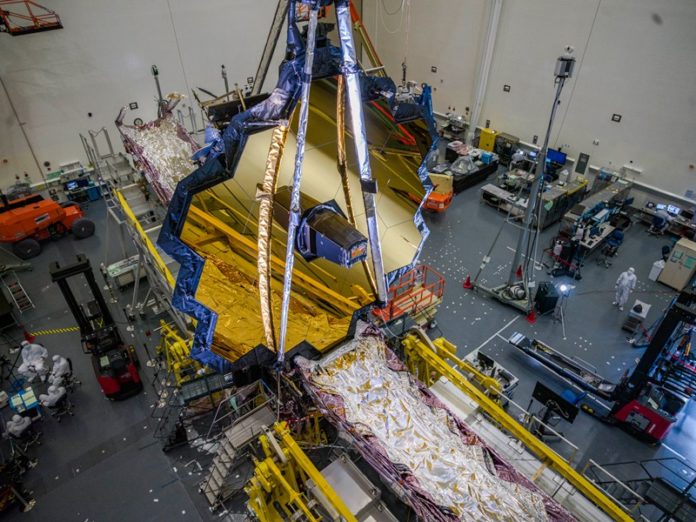- NEWS
You have full access to this article via your institution.
NASA is considering whether to rename its flagship astronomical observatory, given reports alleging that James Webb, after whom it is named, was involved in persecuting gay and lesbian people during his career in government. Keeping his name on the US$8.8-billion James Webb Space Telescope (JWST) — set to launch later this year — would glorify bigotry and anti-LGBT+ sentiment, say some astronomers. But others say there is not yet enough evidence against Webb, who was head of NASA from 1961 to 1968, and they are withholding judgement until the agency has finished an internal investigation.
The JWST, which will peer into the distant reaches of the cosmos, is NASA’s biggest astronomical project in decades, so the stakes are high. In May, citing Webb’s purported involvement in discrimination, four prominent astronomers launched a petition to change the telescope’s name. It has amassed 1,250 signatories, including scientists who have been awarded observing time on the telescope.
NASA’s acting chief historian, Brian Odom, is working with a non-agency historian to review archival documents about Webb’s policies and actions, according to agency officials. Only after the investigation concludes will NASA decide what to do.
“We must make a conscious decision,” Paul Hertz, head of NASA’s astrophysics division, told an agency advisory committee on 29 June. “We must be transparent with the community and with the public for the rationale for whichever decision we make.”
Searching the archives
Former NASA administrator Sean O’Keefe named the JWST after Webb in 2002, when the telescope was in the early stages of development. It was a unilateral decision that took many by surprise, because NASA’s telescopes are typically named after scientists. Webb, who died in 1992, was a bureaucrat who held several administrative roles in the US government.
O’Keefe chose the name because Webb had advocated that NASA keep science as a key part of its portfolio in the 1960s, even as the Apollo programme of human space exploration soaked up most of the agency’s attention and budget. O’Keefe tells Nature he was not aware of the accusations when he picked the name, and he supports keeping it unless more information surfaces. “Without James Webb’s leadership, there may have been no telescope or much of anything else at NASA noteworthy of a naming controversy,” he says.
As Webb was beginning his career with the US government in the late 1940s, gay and lesbian employees were being systematically rooted out and fired because of their sexual orientation — a campaign encouraged by several prominent members of Congress. The period is known as the lavender scare, echoing the anti-Communist ‘red scare’ with which it was often intertwined. During the lavender scare, gay people were cast, untruthfully, as perverts who might be desperate to keep their sexual orientation secret and thus be susceptible to revealing government secrets under blackmail. Its epicentre was the Department of State, which handles foreign policy.
The four astronomers leading the renaming petition say that when Webb worked for the state department in the high-ranking position of undersecretary from 1949 to 1952, he passed a set of memos discussing what was described as “the problem of homosexuals and sex perverts” to a senator who was leading the persecution. They point to records found in the US National Archives by astronomer Adrian Lucy at Columbia University in New York City. “The records clearly show that Webb planned and participated in meetings during which he handed over homophobic material,” the petition leaders wrote earlier this year in an opinion piece in Scientific American.
The four astronomers are Lucianne Walkowicz at the Adler Planetarium in Chicago, Illinois; Chanda Prescod-Weinstein at the University of New Hampshire in Durham; Brian Nord at the Fermi National Accelerator Laboratory in Batavia, Illinois; and Sarah Tuttle at the University of Washington in Seattle. “We felt that we should take a public stand on naming such an important facility after someone whose values were so questionable,” they write in an e-mail to Nature. “It’s time for NASA to stand up and be on the right side of history.”
David Johnson, a historian at the University of South Florida in Tampa who wrote the 2004 book The Lavender Scare, says he knows of no evidence that Webb led or instigated persecution. Webb did attend a White House meeting on the threat allegedly posed by gay people, but the context of the meeting was to contain the hysteria that members of Congress were stirring up. “I don’t see him as having any sort of leadership role in the lavender scare,” says Johnson.
Walkowicz and their colleagues note that as a leader, Webb bore responsibility for discriminatory policies enacted at his agency. They also note the case of Clifford Norton, who was fired from his job at NASA because he was suspected to be gay in 1963, when Webb was NASA administrator. “We believe the known historical record speaks clearly in favour of renaming the telescope,” they say.
NASA has given no estimate of when its investigation might be complete. Odom says that the COVID-19 pandemic has limited historians’ access to archival records.
A reflection of values
The push to rename the telescope falls into the broader reckoning over naming buildings, facilities and other objects after questionable historical figures. Last year, an aerospace executive began an as-yet unsuccessful effort to rename a NASA centre in Mississippi that is named after John Stennis, a senator who voted repeatedly in favour of racial segregation in the 1960s. In the past year or so, NASA has tried to address past discrimination against Black scientists and against women by naming its Washington DC headquarters after Mary Jackson, the first Black female engineer at the agency, and announcing that the flagship space telescope after the JWST will be named after Nancy Grace Roman, NASA’s first chief astronomer.
The JWST debate comes near the end of a long and exhausting push to launch the observatory into space. Originally conceived in 1989 as the successor to the iconic Hubble Space Telescope, the craft is many years and billions of dollars over budget.
To some, the telescope’s potential to transform astronomy makes it even more important that the JWST carry a name that reflects modern values. “For me, it really comes down to what kind of message we want to send to the more junior folks and students in our field,” says Peter Gao, a planetary scientist at the University of California, Santa Cruz. “The people we choose to celebrate by naming our telescopes after them is a reflection of our values.”
The final decision lies with NASA administrator Bill Nelson, who has not said anything publicly on the matter. There is no clear list of alternative names, although many people have made unofficial suggestions. Walkowicz and the other astronomers who are leading the petition suggest Harriet Tubman, after the formerly enslaved woman who fought to end slavery in the United States in the nineteenth century and used the stars to guide Black people to freedom. Saurabh Jha, an astronomer at Rutgers University in New Brunswick, New Jersey, suggests Cecilia Payne-Gaposchkin, whose work revolutionized astronomers’ understanding of the composition of the Universe in the early twentieth century.
Some astronomers who plan to use the JWST are already thinking about what they will do if the telescope is not renamed. One idea is to acknowledge LGBT+ rights in the acknowledgements sections of papers published using JWST data, says Johanna Teske, an astronomer at the Carnegie Institution for Science in Washington DC.
Many are keen to see what the NASA investigation might unearth. “It’s important to look at what happened and what the facts are,” says Rolf Danner, an astronomer at NASA’s Jet Propulsion Laboratory in Pasadena, California, who is chair of the American Astronomical Society’s committee on sexual orientation and gender minorities in astronomy. “And then really ask ourselves — would we make that choice again?”
Nature 596, 15-16 (2021)
doi: https://doi.org/10.1038/d41586-021-02010-x
Related Articles
Subjects









